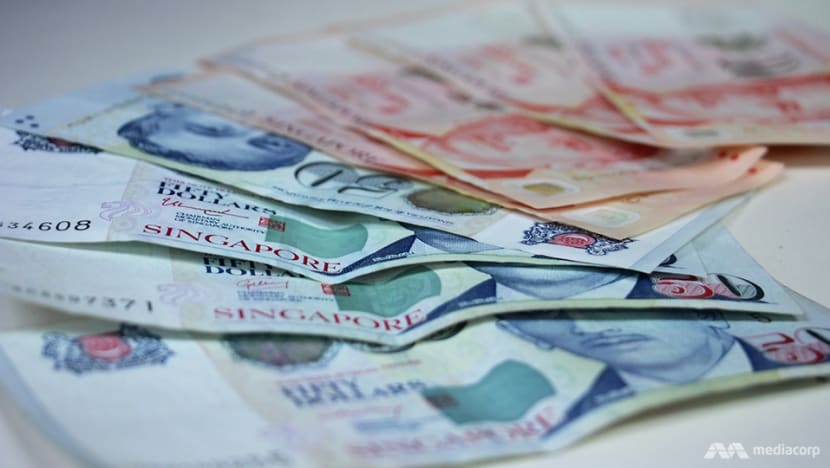The S$NEER and its slope, width and centre: Questions about Singapore’s monetary policy

File photo of the Monetary Authority of Singapore building on Shenton Way. (File photo: CNA/Jeremy Long)
SINGAPORE: At its latest semi-annual review on Monday (Oct 14), the Monetary Authority of Singapore (MAS) made a slight reduction to the slope of its monetary policy band in a widely expected easing move.
This is the first time the central bank has eased monetary policy since April 2016, and comes amid faltering growth in Singapore as a protracted trade war and a global tech downturn continue to weigh on the key manufacturing sector.
Advance data from the Ministry of Trade and Industry on Monday showed the economy narrowly averting a technical recession in the third quarter.
With growth lacklustre and inflationary pressures set to be muted, the MAS said it will “reduce slightly the rate of appreciation of the S$NEER (Singapore dollar nominal effective exchange rate) policy band.”
There will be no change to the width of the policy band and the level at which it is centred.
READ: MAS reduces pace of appreciation for Singdollar 'slightly' amid slow growth
READ: Singapore economy grows 0.1% in Q3, avoids technical recession
“This measured adjustment to the policy stance is consistent with medium-term price stability, given the current economic outlook,” it added in its statement.
Now, what is the S$NEER? What does it mean for you and me when the slope is reduced?
WHAT IS THE S$NEER?
Unlike most central banks that target the interest rate, the MAS uses the exchange rate as its main policy tool.
This refers to the S$NEER – the exchange rate of the Singapore dollar managed against a trade-weighted basket of currencies from Singapore’s major trading partners.
Having a trade-weighted exchange rate - where the currencies of Singapore's larger trading partners bear more weight - better reflects the country’s diverse trading patterns, compared to a bilateral exchange rate between the Sing dollar and a foreign currency, according to a list of frequently asked questions (FAQ) about its monetary policy on the MAS website.
The basket of currencies is “reviewed and adjusted periodically” according to the country’s trade patterns.
To deter speculation, the make-up of this basket is never revealed.
WHY EXCHANGE RATE?
This is because Singapore is a small and open economy with a heavy dependence on trade.
Gross exports and imports of goods and services account for more than 300 per cent of gross domestic product (GDP), according to the FAQ. Almost 40 cents of every dollar spent domestically is on imports.
As such, targeting the exchange rate has been deemed more effective in achieving the central bank’s primary goal – to ensure price stability as a basis for sustainable economic growth.
READ: Singapore added to US currency watchlist: What you need to know
The MAS said the nominal effective exchange rate affects a wide range of prices in the Singapore economy, both directly and indirectly.
These include import and export prices, wages and rentals, consumer prices and output prices.
For instance, if the Sing dollar appreciates against those of major trading partners, it will reduce prices of imported goods and services. This subsequently dampens the prices that households here have to pay.
HOW DOES THE MAS CONDUCT ITS POLICY?
The S$NEER is allowed to float within an unspecified band. Should it go out of this band, the MAS steps in by buying or selling Sing dollars.
It also changes the slope, width and mid-point of this band based on assessed risks to the country’s growth and inflation, and announces these changes at its two scheduled policy meetings.
These meetings typically happen in April and October, unless otherwise necessary.
The last time MAS surprised markets with an inter-meeting move was in January 2015, when it unexpectedly reduced the slope of the band. Then, a sharp drop in global oil prices had caused a significant shift in its inflation outlook.

WHAT ABOUT THE SLOPE?
This is probably the most common tool used by the MAS to adjust the band.
Simply put, the slope determines the rate at which the Sing dollar appreciates. If the slope is reduced, this means the local currency will be allowed to strengthen at a slower pace. It strengthens as a faster pace when the slope is increased.
On Monday, the MAS said it was reducing the S$NEER policy band “slightly”.
Economists believe that the slope still remains positive and that the Sing dollar should be rising by 0.5 per cent a year, down from 1 per cent previously, against the basket of currencies.
“The MAS did not describe policy as ‘neutral’ as a result of the adjustment. We believe this implies the MAS reduced the slope by 50 basis points to an estimated 0.5 per cent, in line with our view,” said Barclays economist Brian Tan.
The last time the MAS flattened the slope was in April 2016 when growth slowed amid a dimmer global outlook.
The central bank held on to that “neutral” stance for two years, before increasing the slope twice in 2018 to a path of “modest and gradual appreciation” as growth and inflation picked up.
WHAT ABOUT THE MID-POINT?
This is a tool generally reserved for “drastic” situations, such as recessions, when the outlook for growth and inflation sees an abrupt and rapid change, said Maybank Kim Eng economist Lee Ju Ye.
Compared to tweaks in the slope, an adjustment in the mid-point either upwards or downwards is likely to yield a quicker and bigger impact on the currency, explained Mr Jeff Ng from Continuum Economics.
“The Sing dollar is managed within an unspecified band and we estimate it to be about 4 per cent. If it’s a drastic change of say 10 per cent, it will technically strengthen or weaken the currency immediately.
“If it’s a small change and still within the allowance, it’s more to reflect how the currency is supposed to be faring across the trade-weighted partners ... but it will still have a strong signaling effect,” Mr Ng.
Past instances of a re-centring in the mid-point include a downward adjustment in April 2009, as the 2008 global financial crisis sent Singapore’s economy into a recession and inflation fell sharply.
By doing so, the MAS was effectively doing the equivalent of a one-off currency devaluation to support the economy. A weaker Sing dollar generally tends to be good news for the country’s exporters as it makes them cheaper and more competitive.
READ: No need for extraordinary budget at this stage: Heng Swee Keat on Singapore economy
READ: Commentary: Here’s a sure-win bet for Singapore companies and workers as recession looms
WHAT ABOUT THE WIDTH?
The width controls how far the Sing dollar can fluctuate. This means the wider the band, the more volatile the currency can be.
It is typically reserved for periods of increased uncertainties or volatility, said Ms Lee.
For instance, the band was widened in October 2001, after the Sep 11 terrorist attacks in the United States led to extreme volatility in the financial markets.
More recently in October 2010, the width was also widened slightly “in view of the volatility across international financial markets”.
SO, WHAT DOES THE LATEST POLICY STATEMENT MEAN FOR YOU?
The slight reduction in the slope will now put the Sing dollar on a slower pace of appreciation.
But the local currency appeared unaffected following the policy review, and was last seen gaining about 0.25 per cent to trade at 1.3699 against the greenback as of 4.20pm on Monday.
This was due to positive sentiment in the market following a “partial trade deal” between the United States and China, experts said.
There were also some expectations in the market for the MAS to do a more drastic easing to a “neutral” stance, but that did not materialise, said Mr Ng.
In the long run, however, analysts generally expect the Sing dollar to weaken against the greenback, with forecasts ranging from 1.4 to 1.43 by end-2019.
Further easing in 2020 also seems to be on the table, some analysts said, given how the central bank noted that it will continue to closely monitor developments and “is prepared to recalibrate monetary policy should prospects for inflation and growth weaken significantly”.
READ: Commentary: Singapore and the dreaded R word - recession
READ: What Singapore’s slowing GDP growth means for the jobs market
Typically, a weaker currency helps to lift growth by making exports cheaper abroad but it also makes imports more expensive in Sing dollar terms.
So what does this mean for you and me? Possibly weaker spending power but it is not all bad news for households here, according to experts.
Opting for a gradual reduction in the appreciation pace will ensure that local interest rates do not spike, Mr Ng said.
In general, a softer Sing dollar can put upward pressure on local interest rates, such as the Singapore interbank offered rate (Sibor), as investors seek higher yields as compensation for holding the weakening currency.
“By not allowing the currency to weaken too much, they are trying to make sure that interest rates don’t rebound too much too,” he explained.
"This is so that when the US cuts interest rates, Singapore’s interest rates can also come down accordingly."












